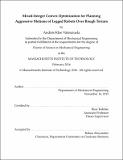Mixed-integer convex optimization for planning aggressive motions of legged robots over rough terrain
Author(s)
Valenzuela, Andrés Klee
DownloadFull printable version (4.271Mb)
Other Contributors
Massachusetts Institute of Technology. Department of Mechanical Engineering.
Advisor
Russ Tedrake.
Terms of use
Metadata
Show full item recordAbstract
Planning dynamic motions for a legged robot entails addressing both the continuous question of how its joints should move and the combinatorial question of which hand or foot should touch which surface and in what order. Fortunately, these two questions are linked by the centroidal dynamics of the robot, which we can express either in terms of its joint angle trajectories or in terms of its foot placements and applied forces. Based on this insight, I formulate a pair of mathematical programs for planning highly dynamic motions for legged robots. The first is a mixed-integer convex program, specifically, a mixed-integer quadratic program (MIQP), that yields a sequence of footholds/handholds as well as center of mass (COM) and angular momentum trajectories. The second is a trajectory optimization, formulated as a nonlinear program (NLP), that returns trajectories for the COM, angular momentum, and joint angles subject to the footholds/handholds chosen by the MIQP step. While any number of trajectory optimization schemes could be used here, we present one which is particularly useful in this case, as it enforces the system's dynamics directly in terms of its COM motion and angular momentum. As a result, the solution to the MIQP provides constraints (where each end-effector is required to make contact with the environment) for the NLP and also gives seeds for the decision variables corresponding to the robot's centroidal motion. Thus, the three primary contributions of this thesis are: an MIQP-based approach to gait selection over irregular terrain, a trajectory optimization formulation for floating-base systems subject to external forces and kinematic constraints, and a planning methodology that integrates both of those to generate highly dynamic motions in challenging environments. I apply these techniques to models of a quadruped and a humanoid (Boston Dynamics' LittleDog and Atlas respectively) to generate motion plans for running, jumping, and other dynamic behaviors.
Description
Thesis: Sc. D., Massachusetts Institute of Technology, Department of Mechanical Engineering, 2016. This electronic version was submitted by the student author. The certified thesis is available in the Institute Archives and Special Collections. Cataloged from student-submitted PDF version of thesis. Includes bibliographical references (pages 79-84).
Date issued
2016Department
Massachusetts Institute of Technology. Department of Mechanical EngineeringPublisher
Massachusetts Institute of Technology
Keywords
Mechanical Engineering.